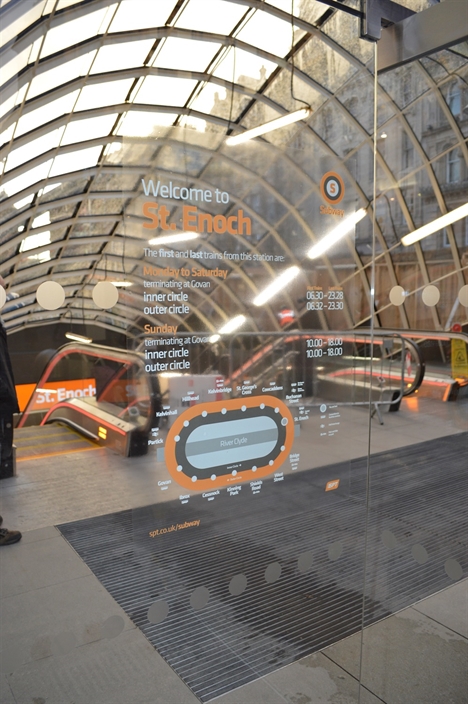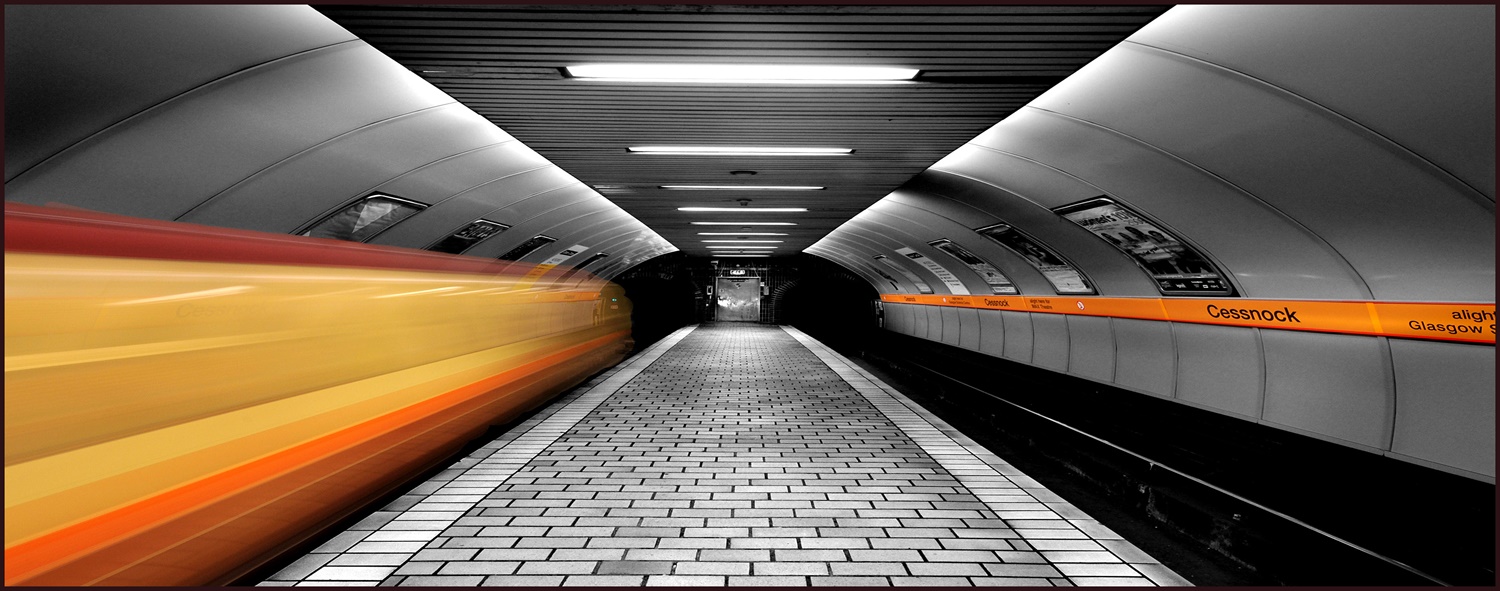01.03.15
‘The Subway is much more than just a transport service’
Source: Rail Technology Magazine Feb/March 2015
Charlie Hoskins, senior director at Strathclyde Partnership for Transport, talks to RTM about the ongoing upgrade of the Glasgow Subway, whose stations, rolling stock, signalling and tunnels are all being improved.
With the recent opening of its new St Enoch canopy entrances at Argyle Street, the announcement on the re-lining of its tunnels and an upcoming decision on new rolling stock, the £300m Glasgow Subway modernisation programme is attracting a lot of interest.
The programme began back in summer 2011 when Hillhead station near the University of Glasgow was overhauled, with upgrades following at Partick, Kelvinhall, Ibrox, and St Enoch stations.
Glasgow Subway is owned and operated by Strathclyde Partnership for Transport (SPT). It is the third oldest underground metro system in the world, after London and Budapest, and has an unusual 4ft gauge (1,220mm) and a tunnel diameter of just 3.4m.
Senior director Charlie Hoskins told RTM: “Progress has been very good and within our overarching Modernisation programme dates. Some elements have been delivered ahead of their individual project timelines; for example St Enoch station. Works at stations are progressing well and we’re learning more each time we finish one and embark on the next.”

Stations
St Enoch station was refurbished by Graham Construction Ltd at a cost of £5.35m, with design support from Aedas Architects (now AHR) and Turner & Townsend. Its Howard Street (south facing) entrance should be completed soon.
SPT’s multi-supplier framework, when appointing contractors for the station works, allows ‘mini-tendering’ and negotiations for the works involved in refurbishing all stations. The other two main contractors besides Graham Construction are Sir Robert McAlpine and Clancy Docwra.

Asked about relationships with those contractors, Hoskins told us: “The relationships with the framework contractors are continuing to develop and getting closer to becoming more collaborative. Our contractors are getting better each time at ensuring that not only disruption to customers is minimised, but also by ensuring that station staff are brought on board by keeping them abreast of the detail of the works.
“Our stations, by their very nature, are extremely constrained, making it essential for our contractors to have very well thought-out plans in place to deal with even the smallest of issues. We manage our costs very firmly within the contractual approach we have taken, whilst being aware of the need to respond to the unknowns that we find in an 118-year-old system. We look to our contractors to maintain both their and our reputation in keeping to this guiding principle, and thus far the relationships have worked well.”
Despite their constrained size, SPT keeps the stations open throughout the refurbishment work. “Whilst deadlines are key to completing the refurbishment contract, the need to remain open throughout to serve our customers takes precedence,” Hoskins explained.
The next station to be upgraded is Buchanan Street, with that contract again going to Graham Construction, for £3.17m.
Track and depot
SPT has recently awarded a £1.1m contract for the manufacture and supply of rail to Austrian-based Voestalpine Schienen GmbH under a three-year call-off contract, plus £458,000 worth of track chainage replacement works to Malcolm Hughes Land Surveyors Ltd.
Voestalpine Schienen was one of only two bidders, alongside Tata Steel, because of the unusual profile of the rail.
A programme of accelerated re-railing has been launched to ensure the worn rail is replaced before the new rolling stock is introduced, because significant testing and commissioning will limit network access to complete normal levels of maintenance.
It has also awarded a £5m design and build contract to Colas Rail to renew the Subway ramps and turnout chambers at the Broomloan depot, the only point of access for trains to enter and leave the Subway loop, and the only cross-over between the clockwise Outer and anti-clockwise Inner circles.
SPT chief executive Gordon Maclennan said: “Given the ramps and turnout chambers are well over 30 years old, we believe it is prudent to have them completely renewed to sustain the infrastructure for many more years to come.”
Smart ticketing
At the end of 2013, SPT completed its transitions from the existing magnetic stripe system to the new Smartcard system over the course of 15 weeks. The ITSO-compliant system uses a technology called Bramble, and won the ‘Excellence in Technology and Innovation’ category at the Scottish Transport Awards last year. It was developed and delivered by Ecebs and Nevis working with SPT.

Hoskins said: “Our Operations staff worked extremely hard during this time, managing two completely different systems in parallel. We are beginning to see significant success with 70,000 Smartcards now in circulation, which is very encouraging.
“We witnessed a modest increase in passengers, which we could attribute to the launch of the new Smartcard, given the timing of the increase, as well as the station refurbishments. Our challenge is to keep the old infrastructure available in order for our existing trains to operate reliably whilst delivering the Subway Modernisation works.”

Tunnels
In December, SPT awarded the £17m contract to upgrade the Subway’s tunnel lining to Telford-based Freyssinet Ltd. This covers “a programme of targeted and prioritised tunnel lining works including water sealing, void filling, lining repairs and trackbed repair”.
The bulk of repairs will be undertaken in tunnels running from Hillhead station in the west end to Buchanan Street station in the city centre, a stretch which also incorporates Kelvinbridge, St George’s Cross and Cowcaddens stations. Another high priority is a section of tunnels in the southside of Glasgow between Shields Road and Kinning Park.
But SPT chose to avoid a full-scale shutdown, choosing to do works short of a full watersealing and re-lining of the entire 10.5km tunnel, which would have required “significant reconstruction of the entire lining with major closures of the system and was not considered a viable option”.
Asked to explain this decision, Hoskins told us: “During the early stages of the business case, several options were explored and during this process we assessed that it wasn’t economically viable to conduct major closures to undertake a re-lining exercise, with months and potentially into years of disruption. We have worked hard in challenging our engineers since Modernisation began with the best balanced approach, whereby we tackle those high priority areas experiencing significant water ingress first. We of course keep a constant watching brief on all areas of the tunnels and will be treating these areas with smaller scale works in due course. We are confident that this risk-based approach achieves the best balance of budget, time and availability for carrying out this type of work.
“Tunnel linings works are programmed to be undertaken during the current possession times, as are all other tunnel maintenance and rail renewal activities.”
SPT says Freyssinet Ltd “was able to demonstrate that they have considerable experience of undertaking works of this nature” and that their £16.8m bid was the “most economically advantageous”, ahead of costlier submissions by Balfour Beatty and BAM Ritchies.

(Photo credit: Kevin Smyth. Creative Commons)
Signalling and trains
The procurement exercise for a new signalling system is to be concluded later this year, and until then some of the details remain unknown or under wraps. Systra was appointed back in 2012 as client technical advisor on the package.
Hoskins said: “What we can say at this stage is that the signalling performance specification is based on an increased capacity and frequency compared with the current system and will be very much centred around automation.”
The new signalling proposals are part of a wider ‘integrated systems’ procurement package that also includes new driverless rolling stock, platform screen doors, a new control centre and associated improvements.
The signalling system will be full UTO (unattended train operation, the highest of five grades of train automation on the International Association of Public Transport scale), reducing headways. SPT noted then that it would be learning from Paris Line 14, which it said “correlates very closely” with the Subway in terms of migrating to a fully automated system.
The current rolling stock operates in three-car formation, with 33 power cars and eight trailer cars having been built. All cars are used in rotation with 12 sets running at peak times of service. Traction is via 600V DC third rail and they are based at Broomloan Depot in Govan.

(Photo credit: Southside Images. Creative Commons)
When SPT first decided to push ahead with a rolling stock renewal, it took market soundings from many major manufacturers and rail businesses. It was made clear at this time that there was no ‘off-the-shelf’ train or design to fit the Subway’s track gauge or tunnel dimensions, meaning costs are likely to be higher than typical.
Although SPT has not publicly confirmed the bidders, there has been wide media speculation that those included are a consortium of Ansaldo (whose rail operations are being acquired by Hitachi) with Stadler Rail and Babcock; Spain’s CAF; and France’s Thales.
The Scottish government is providing significant investment into the Subway upgrade: £246m of grant funding.
Although there have in the past been proposals to expand the Subway, these have never progressed, partly because of the difficult geology and geography. Asked about future plans, Hoskins told us: “We are currently focusing on the modernisation of the existing system.”
‘Huge symbolic meaning’
Finally, we asked Hoskins how important the Subway is to Glasgow – in transport terms, and symbolically?
He said: “In transport terms, the Subway is a fundamental part of the overall transport network in Glasgow. For example, it plays a vital role in carrying a significant proportion of fans to Ibrox Stadium on match days, as well as commuters to and from work every day. Subway is also an integral part of the wider transport network, providing a key mode of access to universities, hospitals, shopping and leisure opportunities across the city. Govan Interchange will form a key part of the public transport network for the New South Glasgow University Hospital, which has recently been handed over to the NHS to commence an 18-month transition to full operational service.
 “The Subway is, by its very nature, much more than just a transport service. It holds huge symbolic meaning and affinity with Glaswegians, as well as those from further afield. We fully respect that we are custodians of this historic and much-loved icon and whilst ensuring the day-to-day operation of the Subway for the travelling public, we also have to bear in mind that our system was a product of the Victorian era and must be handled with just that little extra care and attention.”
“The Subway is, by its very nature, much more than just a transport service. It holds huge symbolic meaning and affinity with Glaswegians, as well as those from further afield. We fully respect that we are custodians of this historic and much-loved icon and whilst ensuring the day-to-day operation of the Subway for the travelling public, we also have to bear in mind that our system was a product of the Victorian era and must be handled with just that little extra care and attention.”
Tell us what you think – have your say below or email [email protected]